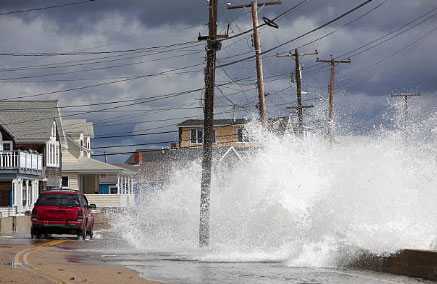Vibrio vulnificus Infections and Disasters
DISASTER RECOVERY FACT SHEET

If you are in an area where hurricanes, storm surges, and coastal flooding are possible, it’s important for you to know about a harmful bacteria called Vibrio vulnificus and steps you can take to reduce your risk of infection.
Questions and Answers
What is Vibrio vulnificus?
Vibrio vulnificus is one of about a dozen species of Vibrio bacteria that can cause human illness, called vibriosis. Vibrio naturally live in certain coastal waters and are present in higher concentrations between May and October when water temperatures are warmer. Those months overlap with the time when hurricanes and tropical storms are more likely to affect the U.S. mainland and many U.S. territories.
Who is more likely to get a Vibrio vulnificus infection?
Anyone can get a Vibrio vulnificus infection. People with a compromised immune system or liver disease are more likely to get an infection and severe complications. Learn about other medical conditions that increase your chance of infection.
How do people get a Vibrio vulnificus infection?
In the United States, people most often become infected with Vibrio vulnificus and other species of Vibrio by eating raw or undercooked shellfish, particularly oysters. Certain Vibrio species, including Vibrio vulnificus, can also cause a skin infection when an open wound is exposed to brackish or salt water. Brackish water is a mixture of fresh and sea water that is often found where rivers meet the sea.
When a hurricane or storm surge causes flooding, you may be exposed to coastal water. If you are in a group more likely to get a Vibrio vulnificus infection, it is especially important to take steps to reduce your risk of infection.
Learn how to reduce your risk of Vibrio infection from raw or undercooked oysters or other shellfish or contact with their juices.
How can I protect myself from a Vibrio vulnificus infection during hurricanes and other natural disasters?
You can reduce your risk of infection by following these tips regarding wounds:
- Stay out of brackish or salt water if possible if you have a wound. Cover your wound with a waterproof bandage if there’s a possibility it could come into contact with brackish or salt water, raw seafood, or raw seafood juices.
- Wash wounds and cuts thoroughly with soap and water if they have been exposed to brackish or salt water, or raw seafood or its juices.
- If you develop a skin infection, tell your medical provider if your skin has come into contact with brackish or salt water, raw seafood, or raw seafood juices.
Wounded during a disaster? Learn how to take care of minor wounds and when to seek medical care.
What kinds of illnesses can a Vibrio vulnificus infection cause?
Vibrio vulnificus can cause two types of illnesses: 1) wound infections, which may start as redness and swelling at the site of the wound that can spread to affect much of the body, and 2) primary septicemia, a bloodstream infection with symptoms including fever, dangerously low blood pressure, and blistering skin lesions.
Are Vibrio vulnificus infections serious?
Yes. People with a Vibrio vulnificus infection can get seriously ill and need intensive care or limb amputation. About 1 in 7 people with a Vibrio vulnificus wound infection dies.
Vibrio vulnificus does not cause cholera. Cholera is an epidemic waterborne diarrheal disease caused by another type of Vibrio; cholera rarely occurs in developed nations.
What are the symptoms of a Vibrio vulnificus infection and when do they usually start?
Symptoms of a Vibrio vulnificus infection include:
- Serious illness, with a rapid decline in health;
- Watery diarrhea, often accompanied by stomach cramping, nausea, vomiting, and fever;
- Skin infection after an open wound is exposed to brackish or salt water;
- Bloodstream infection, with fever, chills, dangerously low blood pressure, blistering skin lesion, and sometimes death.
How is a Vibrio vulnificus infection diagnosed and treated?
Infection is diagnosed when Vibrio bacteria are found in the wound, blood, or stool (poop) of an ill person. Vibrio vulnificus infection is treated with antibiotics. Limb amputation is sometimes necessary to remove dead or infected tissue.
See guidance for health professionals on emergency wound management and management of Vibrio vulnificus wound infections.
How many people get a Vibrio vulnificus infection in the United States each year?
CDC estimates that Vibrio vulnificus causes about 205 infections in the United States every year.
- Page last reviewed: August 31, 2017
- Page last updated: August 31, 2017
- Content source:


 ShareCompartir
ShareCompartir

